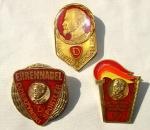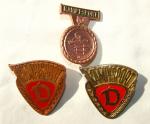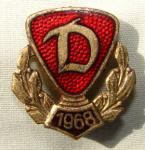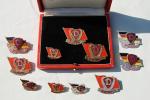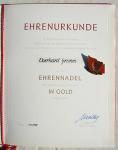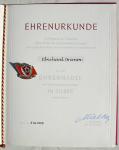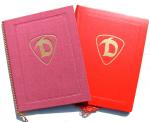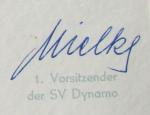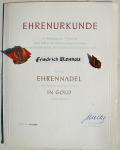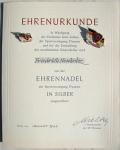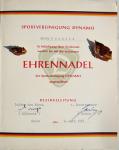-
Posts
1,742 -
Joined
-
Last visited
-
Days Won
3
Content Type
Profiles
Forums
Blogs
Gallery
Events
Store
Everything posted by Greg Collins
-
Last, for now, a Dynamo flag complete with paper label and hung, unceremoniously, on my clothes line.
-
Some Dynamo stick pins. The various locations had specific pins, while the plain "D" pins were general. The "Sports Club" pin was for Berlin.
-
A gold and silver Bestenermittlung (good determination) badge... I don't have a date on these. These were for police, and you can see the police "star" joined to the D.
-
All three Dzierzynski Sportler badges from SG Adlershof. The top badge was given between 1969-1989; the other two from 1988-1989.
-
A couple of next-to-last-model Kampfsport badges (ignore the top badge- I'll discuss that in another post). These are bronze and silver, although the silver has, apparently, been coloured by the tree-sap resin coating.
-
-
A collection of Dynamo honour badges. The red case is for the full sized gold badge. The badge I'm lacking is the gold badge with tri-colour flag- still looking.
-
-
This post would not respond to Full Editor.
-
Next, the full sized gold badge and document, to the same individual, dated 1979. Again, Erich Mielke's hand signature (must have been reserved for gold).
-
The silver full sized badge and document from 1973 (the first year of the "red flag" issue). Erich Mielke's signature is stamped.
-
The previous documents did not come to me with mappe (document covers); the next two did; the silver in a dark red cloth covered mappe and the gold in a red leatherette mappe.
-
A detail of Mielke's hand signature on the previous document. It seems he used a ball point when signing this.
-
The next image is the gold honour badge (full size and miniature) to the same individual. The flag of the badge went from the tri-colour to red in 1973; this document is dated 1977. Note Erich Mielke's actual signature here.
-
Next, the silver honour badge (full size and miniature) and document to the same individual in 1968. Note Erich Mielke's stamped signature.
-
The Dynamo was the sports organization of the Ministry for State Security and the Police. It was divided into three sizes- the SC (sport club), the SG (Sportgemeinschaft- Sports community), and the SV (Sportvereinigung- Sports association). The SG Dynamo could have several SC Dynamos attached to it while the SV Dynamo could have several SG's and associated SC's attached to it. The SC Dynamo would concentrate on a single sport; the SG's would have a couple to a few sports under the same roof; the SV would have several sports under the same roof. The main Dynamo was SV Dynamo Berlin, and was headed by Erich Mielke- head of the Stasi- from it's inception in 1953 until 1989. I have a reasonable collection of Dynamo items I thought I'd share. First off, an early bronze honour badge (full size and miniature) and document from 1961.
-
Romania Three Communist Romanian Ribbon Bars.
Greg Collins replied to Kev in Deva's topic in Central & Eastern European States
Hey Kevin, Again, great bars (a couple of the final image bars seem to be a little on the "rode hard and put up wet" side of things)! The weird thing is you seem to have gotten only one military bar (the first is either Security Troops or Militia) and the rest seem to be civilian (Party members). I have seen duplicate ribbons as well- commemoratives at that- on the same bar and always thought that was peculiar. I guess that's part of the joy of collecting Romania. The first time I ran across a ribbon bar without military awards I thought it fake until I found a site for an organization investigating crimes under the Communist regime. They have a great collection of photos and, sure enough, found Party members at anniversaries wearing ribbon bars on their suits- most too young to be veterans. May have also happened in the DDR. -
Romania Romanian Ribbon Bars
Greg Collins replied to Greg Collins's topic in Central & Eastern European States
OK, fair enough... must have been to even the bar rows out for more stability. I guess seeing all the women in uniform in uniform (especially the USSR) gave me the inaccurate idea that the same was true throughout the Warsaw Pact. -
Romania Three Communist Romanian Ribbon Bars.
Greg Collins replied to Kev in Deva's topic in Central & Eastern European States
Great ribbon bar, Kevin! The first award is actually the second class (silver) of the Medal for Service to Socialist Country. -
Romania Romanian Reference Materials
Greg Collins replied to Greg Collins's topic in Central & Eastern European States
One thing I have found about collecting is that, over the years, you learn. And, while I do not profess fluency in Russian, German or Romanian, I have had my nose stuck in various manuals such as Avers and Bartel's or websites such as Okazii over several years to the extent that I can usually figure out what I need to know about an award or badge whether it be written in Russian, German or Romanian. I believe most collectors are in the same boat as I with respect to this. And yes, there's always Bablefish.:beer: -
Romania Romanian "RSR" Cap Badge
Greg Collins replied to a topic in Central & Eastern European States
Rick, You are thinking in the same way I thought at the beginning... trying to integrate Western Military logic into deciphering Romanian rank patterns. Doesn't work here. Basically, three (3) rows of leaves surrounding the State seal are Generals (in this case, the rows are embroidered); two (2) rows are for Lieutenants through Colonels; one (1) row is for Sergeants and Warrant Officers; no (0) rows but with an enameled State seal on oval is for cadets; no (0) rows and with an oval with State seal impressed (no enamel) is for all ranks lower than Sergeant. Occasionally, you'll run across an enameled State seal with no oval behind it and it may still have a dark red cloth backing attached- that is for a member of the Patriotic Guard. Gold colour is for all branches of the Armed Forces, including the Security Troops. Silver colour was reserved for the Militia (Police). The only way to tell the actual rank of an individual was on the shoulderboards (epoleti). The cap badge and collar insignia only put you in the ballpark. Take a look at the Romanian Cap Badges thread- I have shown examples of all except General. -
Romania Romanian Reference Materials
Greg Collins replied to Greg Collins's topic in Central & Eastern European States
I think you're absolutely right! I've used Anatoly's catalog for nearly 6 months now and it has helped clear up a lot of questions... especially when it comes to variants of the same award. A GREAT site! -
Bulgaria Bulgarian Awards Reference Books
Greg Collins replied to a topic in Central & Eastern European States
"Emissions" seems to be a Bulgarian thing... I first encountered that when looking at a Bulgarian-owned on-line business. It follows through onto the pages of the book shown. In Dr. Riemer's book, the terms "variation" and "type" are most often used. Paperwork is also shown in the Riemer book. I'm going to make the term "Slavobabble" a part of my daily vocabulary from this point. Great word! -
Romania Romanian Reference Materials
Greg Collins replied to Greg Collins's topic in Central & Eastern European States
Hey Rick, They are quite out-dated prices. Maybe good for comparison, but that's about it. One thing I especially like about this book is that Schmitt shows which awards had versions that were struck in precious metal (gold) along with the brass versions, although no numbers are given as far a production runs- and that includes all metals. I really wonder if records of that exist??? You and I are probably more used to the precision of both Soviet and East German methods- accountability, accurate book keeping, "this is this and that is that". What I've found as I moved closer to the warmer climate of the Black Sea (Romania and Bulgaria) is a much more "laid back" approach to these sorts of things. Maddening at first, but easy enough to get used to.






